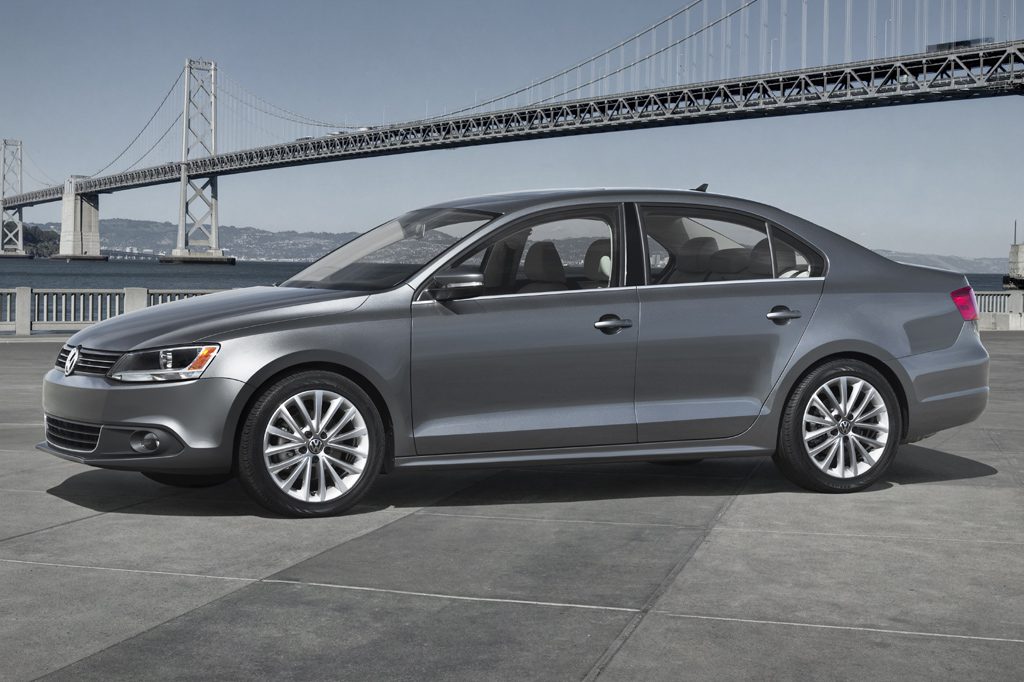| Compact car; Built in Mexico |
|
|
| Good condition price range: $5,200 – $23,200* |

2011 Volkswagen Jetta Front

2011 Volkswagen Jetta Rear

2011 Volkswagen Jetta Interior
| Pros: |
|
| Cons: |
|
Volkswagen’s redesigned compact took some notable steps forward in the realms of passenger and cargo room, as well as powertrain refinement that exceeds the class norm. Unfortunately, Jetta also took a few steps backward with a ride/handling balance and quality of interior materials that fall short of the lofty standards we expect from a Volkswagen. The sporty GLI of 2012 addresses both of these concerns, but it commands a healthy price premium–new or used. On the other hand, continued availability of a thrifty diesel engine helps make this compact a more appealing entry. This is still a good all-around package with enough positive attributes that will appeal to those who are new to the brand. VW loyalists, on the other hand, may lament Jetta’s more mainstream attitude in this generation.
Overview
Redesigned for 2011, Volkswagen’s Jetta sedan got freshened styling along with larger exterior and interior dimensions. Volkswagen’s best-selling car returned as a four-door sedan. The Jetta SportWagen station wagon continued on sale, using the same basic design as the 2006-2010 Jetta; please see that report for a description and our evaluation of the SportWagen, though year-to-year changes (which were few) are listed below.
The 2011 Jetta sedan was more than 3.5 inches longer overall, with 2.6 inches more rear legroom than the 2006-2010 Jetta. Trim levels included S, SE, SEL, and diesel-powered TDI. Jetta S models held a 115-horsepower, 2.0-liter four-cylinder engine. SE and SEL models used a 170-horsepower, 2.5-liter five-cylinder, which carried over from the previous-generation Jetta. The TDI had a 140-horsepower, 2.0-liter turbodiesel four-cylinder. A five-speed manual transmission was standard on the S, SE, and SEL. A six-speed manual was standard on the TDI. Optional on the S, SE, and SEL was a six-speed automatic. The Jetta TDI could be equipped with a six-speed dual-clutch automated-manual transmission that behaved much like an automatic. Standard safety features included all-disc antilock braking, traction control, an antiskid system, curtain side airbags, and front side airbags. Rear side airbags were no longer available. A Convenience Package for the SE included 16-inch alloy wheels, faux leather upholstery, satellite radio, wireless cell-phone link, and heated front seats. SEL models included keyless access/engine start, 17-inch alloy wheels, and a navigation system. A Sport Package for the SEL included a sport suspension, sport seats, and specific trim. The navigation system was optional on the TDI model. A sunroof was standard on the TDI and optional on the SEL and SE with Convenience Package. Jetta sedan competitors included the Chevrolet Cruze, Ford Focus, and Hyundai Elantra.
Yearly Updates
| 2012 Jetta A sport-themed Jetta GLI sedan debuted for the 2012 model year. Fitted with a performance suspension, the GLI used a 200-horsepower, turbocharged 2.0-liter four-cylinder engine, mating with either a six-speed manual gearbox or a six-speed automated-manual transmission. The uplevel GLI Autobahn had faux leather upholstery and heated front seats. Also for 2012, the Sport Package for the SEL was discontinued, while the SEL and TDI models now offered a Fender audio system. On the Jetta SportWagen station wagon, rear-side airbags were no longer available, and the manual transmission offered on the base S model switched from a five-speed to a six-speed. |
| 2013 Jetta The biggest news was the addition of a gas/electric hybrid model, which complemented the existing gasoline and diesel-powered models. It was offered in Base, SE, SEL, and SEL Premium versions. The Hybrid Base had more standard equipment than most other Jettas, including pushbutton start, HD Radio, and dual-zone automatic climate control. The Hybrid SE included satellite radio and specific trim. Hybrid SEL added a navigation system, heated front seats, and a power driver seat. At the top of the Hybrid lineup was the SEL Premium, which had a rearview camera, Fender audio system, and bi-xenon headlights. There weren’t too many changes for the 2013 version of the GLI. All GLIs with VW’s “DSG” dual-clutch automated manual transmission added a Launch Control function. The driver could engage it when the car is at a stop, allowing the car to accelerate from a stop with controlled wheelspin. The top-of-the-line GLI Autobahn with Navigation added a rearview camera, bi-xenon headlamps, and LED daytime running lights. Jetta SportWagen saw no significant changes for 2013. |
| 2014 Jetta Jetta sedans were no longer available with the 2.5-liter 5-cylinder engine, and the base engine switched to a turbocharged 1.8-liter 4-cylinder. All sedans now came with a fully independent rear suspension. A rearview camera was now included on higher trim levels and Volkswagen’s Car-Net communications system/smartphone app became available. Late in the model year, a 30th Anniversary version of the sporty GLI sedan debuted. SportWagens were largely unchanged, but TDI models added a rearview camera. |
